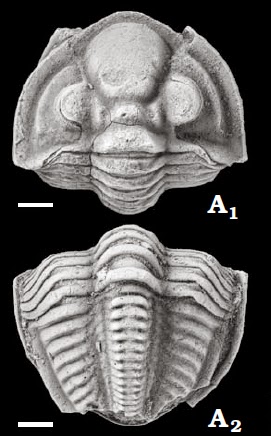Trilobites dominated the seas of the early Palaeozoic, but suffered
a major loss of diversity in the Devonian extinction and became extinct at the
end of the Permian. For a long time it was assumed that the group was in
decline before this final extinction event, but a series of recent discoveries
have shown the group underwent a significant expansion in the Permian Period,
particularly in the eastern Tethyan Realm, which today outcrops from Sicily in
the west across Arabia and South Asia to Timor in the east.
In a forthcoming paper in the journal Acta Palaeontologica Polonica
available online from 30 December 2014, Richard Fortey of the Department of Palaeontology at The Natural History Museum and Alan Heward of Malvern in
Worcestershire, England, describe a new Trilobite fauna from the
Early-to-Middle Permian Qarari Unit in northeastern Oman.
The fauna comprises five previously undescribed Proetoid Trilobites,
with affinities to other southern Asian Permian Trilobite faunas, particularly
those of the Artinskian limestones of Afghanistan. The Trilobites are preserved
in thin-bedded fine-grained limestones interpreted as having come from bellow
the storm wave base in a shallow marine environment, with well-oxygenated
waters. The vast majority of the Trilobires are preserved in an encapsulated
state, leading Fortey and Heward to speculate that they may have died as a
result of some sudden environmental stress, which provoked a defensive response
before death.
The first new species describedis placed in the genus Hentigia and given the specific name ornata, in reference to the elaborate
sculpting on the cephalic (head) region. This Trilobite is 1-1.5 cm in diameter
when encapsulated and has a glabella (face, front part of the cephalic region),
which is enlarged and covered in tubercles.
Ditomopygine Trilobite Hentigia ornata from Kungurian–Roadian (Permian) of Wadi Khawr al
Jaramah, Oman. (A) Enrolled completespecimen, in dorsal (A1), lateral
and(A2) views. Scale bars 2.5
mm. Fortey & Heward (2015).
The second new species described is placed in the genus Iranaspidion and given the specific name
elephas, meaning ‘Elephant’ for its
prominent cheek tubercles and the shape of its hypostome, which resembles an
Elephant’s head with ears extended when viewed from the rear.
Ditomopygine Trilobite Iranaspidion elephasfrom Kungurian–Roadian (Permian) of Wadi Khawr al
Jaramah, Oman. (A)Enrolled complete specimen; cephalon in dorsal (A1)
and anterior (A2) views; pygidium and half thorax in dorsal view (A3). Scale
bars 2.5 mm. Fortey & Heward (2015).
The third new species described is placed in a new genus, Simulopaladin, meaning ‘similar to Paladin’ another genus of Trilobites.
The genus Paladin was originally used
to describe deepwater Trilobites from the Carboniferous of North America,
though a number of Permian shallow marine Asian species have subsequently been
added to the genus. Fortey and Heward suspect that these Permian Trilobites are
erroneously placed in the genus, and erect the genus Simulopaladin to describe this Omani species, pending a review of
the group. It is given the specific name tridentifer,
meaning ‘carrting three teeth’, in reference to three tubercles on the
occipital ring (back part of the cephalic region).
Ditomopygine Trilobite Simulopaladin tridentifer from Kungurian–Roadian (Permian) of
Wadi Khawr al Jaramah, Oman. (A) Holotype, enrolled complete specimen; cephalon in
dorsal view (A1); pygidium and half thorax in dorsal (A2)
view. Scale bars 2.5 mm. Fortey & Heward (2015).
The fourth new Trilobite described is placed in the genus Acanthophillipsia, and given the
specific name felicitae, in honour of
Felicity Heward who collected some of the specimens. This species is described
from only two specimens, one of which is crushed. The cephalic region of this
species is almost completely covered in tubercles.
Ditomopygine Trilobite Acanthophillipsia felicitae.(F) Enrolled complete specimen; pygidium
and half thorax in dorsal view (F1); cephalon in dorsal (F2),
lateral (F3), and anterior (F4) views. (G) Enrolled
complete specimen; pygidium and half thorax inlateral (G1), dorsal
(G3), and anterior (G4) views; cephalon in dorsal view (G2). Scale
bars 2.5 mm. Fortey & Heward (2015).
The final new species described is placed in the genus Triproetus, and given the specific name bonbon, for its resemblance to a boiled
sweet. This has a swollen, bulging glabella with a fine tuberculate surface.
Proetid Trilobite Triproetus
bonbon (A) Enrolled complete specimen; cephalon in dorsal (A1)
and lateral (A2) views. Scale bars 2.5 mm. Fortey & Heward (2015).
See also…
 Preserved Trilobite digestive tracts from the Middle Cambrian of Utah. Trilobites were a group of Arthropods that flourished throughout the
Palaeozoic, but died out at the end of the Permian. They are abundant
and well studied fossils, but little is known of their internal
anatomies.
Preserved Trilobite digestive tracts from the Middle Cambrian of Utah. Trilobites were a group of Arthropods that flourished throughout the
Palaeozoic, but died out at the end of the Permian. They are abundant
and well studied fossils, but little is known of their internal
anatomies.
Follow Sciency Thoughts on Facebook.





